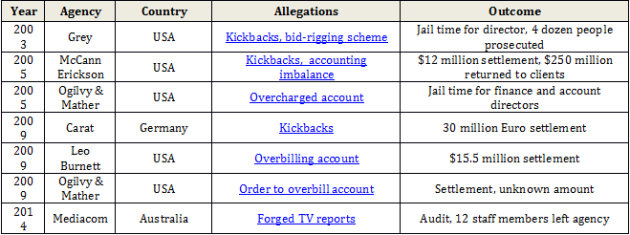
The ANA report on transparency in the US advertising industry has finally been released and the revelations are alarming: AdNews summarised, “rebates were often accepted with the knowledge of, or mandated by, senior executives - indicating a problem from ground level to the upper echelons of agencies.”
AdAge reported further that “markups on media sold through principal transactions ranged from approximately 30% to 90%, and media buyers were sometimes pressured or incentivized by their agency holding companies to direct client spend to this media, regardless of whether such purchases were in the clients' best interests.”
These findings are based on interviews with 150 executives, conducted by the independent consultancy K2 Intelligence. Hence, it seems reasonable to assume the ANA study is solid and provides evidence for pressing issues to address in adland.
Interestingly, many big holding companies immediately attacked the ANA report (partly even before it was released) and complained that it would be unfair to make such broad allegations and not to mention the bad actors instead. Some may regard this as a brilliant PR move (knowing ANA will not name and shame). Others may be reminded of Shakespeare’s Hamlet: “The lady doth protest too much, methinks.”
The key question on many people’s mind is: how big of an issue could unethical or illegal business practices in agencies be?
Let’s review recent media history under lens of this question.
Anecdotal and anonymous reports
Leading trade press outlets, such as AdNews, mUmbrella, AdAge, and DigiDay, have reported for years about the reality of kickbacks, hidden arbitrage and other murky tricks of agencies to increase their income. In addition, several well-respected industry figures (plus myself) have raised concerns about widespread malpractice and conflict of interest that can be exploited by agencies: Jon Mandel (former MediaCom CEO), Simon Rutherford (CEO Slingshot), Andrew Hughes (former head of technology IPG Mediabrands), and most recently Deborah Morrison (director of UK advertisers’ association ISBA), who stated she ”does not believe anymore that media agencies have got the best interest of their clients at heart and that the issue of kickbacks has been exacerbated by the growth in digital spend.”
Uncovered scandals and allegations
Sadly, anecdotal evidence is not the only evidence that has appeared on questionable business practices in agencies. For example, I found the following cases from the last 13 years:

The incidences above illustrate that kickbacks and other illegal issues have been a problem for quite some time. Of course, these are individual cases. However, they demonstrate that unethical or illegal behaviour can even happen among the best companies.
Moreover, while some people may argue that the number of cases seems limited, one should keep in mind that this may just be the tip of the iceberg. Fraudulent corruption schemes, such as undisclosed conflict of interest, kickbacks, and bid rigging are very difficult to uncover, which is why it’s impossible to accurately estimate the real damage.
Whining about declining fees, but reaping record profits?
One of the reasons often cited for hidden income are the lower fees agencies obtain for client work nowadays. Indeed, in his best-selling book Madison Avenue Manslaughter, Michael Farmer shows that agencies have had a 4.5%-per-year annual compound decline in retainers and fees per client since 1992.
Yet, the big holding groups report record breaking profits (see here, here, here and here). Straightaway, two questions arise:
1) Can we really blame procurement teams to push prices down if they read such headlines?
2) If customers pay officially less, but large agencies generate higher profits – where is this money coming from?
Business as usual or a fresh start?
Considering all the facts – ANA report, expert comments, historic cases and suspicious profits – it appears difficult to deny that the media industry needs to do some self-reflection in terms of where it is headed.
We basically have two options now: we can continue to ignore the problems (however big they may be) and maintain a culture of covering up until everything explodes.
Or we can perform a clean-up, reboot and create a sustainable business model.
Pursuing the latter means we need clients who sincerely seek collaboration but also ask tough questions and do not give in if their trust is exploited (even if they are offered a dozen more business lunches and extra account directors). We need transparent processes where agencies are open but also determined about what they charge for. We need sales people who learn to say “no” to clients’ requests if these are not feasible or unrealistic. And we need to strictly separate media planning/ auditing and buying/ execution functions to eliminate the massive conflict of interest that undermines trust by design.
For the sake of all those hard-working people who simply love this creative, exciting and challenging industry, let’s start sooner rather than later.
By University of South Australia senior research analyst, Nico Nuemann


